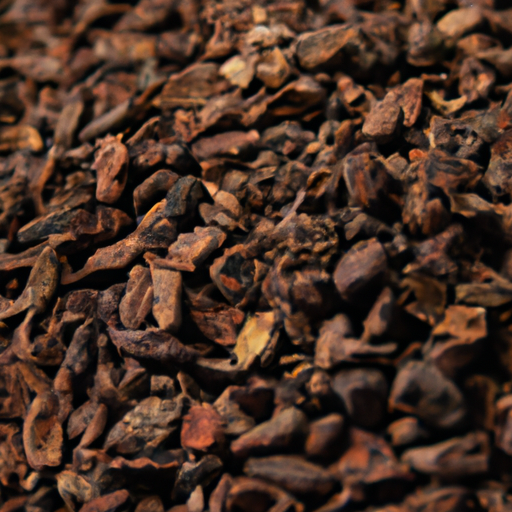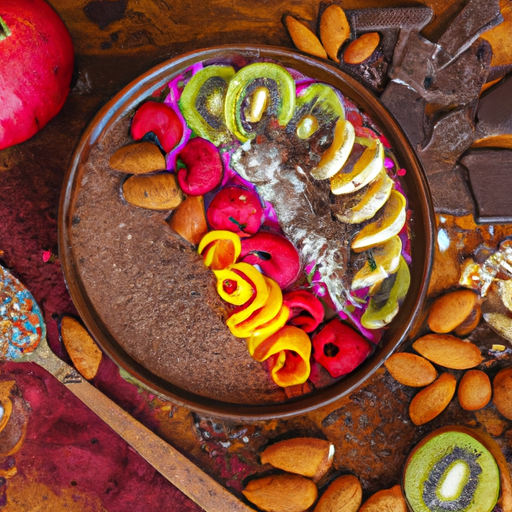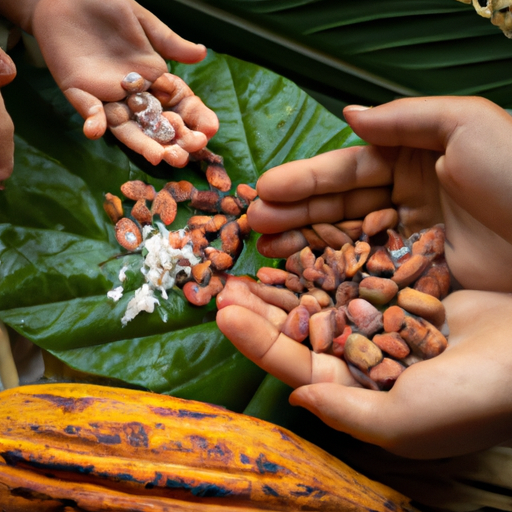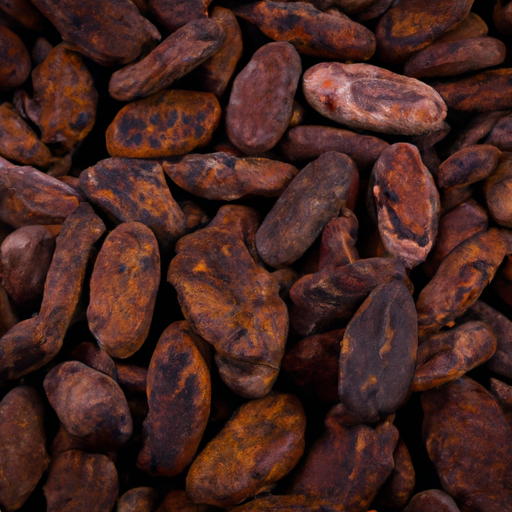Raw cacao nibs are the heart of chocolate, coming from the seeds of the cacao tree. These tiny, crunchy bits have a rich, bittersweet flavor that forms the basis for all chocolate products.
As a food scientist, I’ve delved into the technical aspects of cacao nibs, exploring their composition, nutritional profile, and processing methods.
In this article, we’ll explore the fascinating world of raw cacao nibs, uncovering their origin, nutritional benefits, and potential side effects. With research-based information and an objective perspective, we’ll provide a comprehensive understanding of these versatile nibs.
Whether you’re a chocolate lover or seeking a nutritious addition to your diet, raw cacao nibs offer a tantalizing experience that goes beyond mere indulgence.
Key Takeaways
- Raw cacao nibs are derived from the seeds of the cacao tree and have an intense, bittersweet taste.
- Cacao nibs are high in antioxidants, minerals like magnesium, iron, and zinc, and heart-healthy fats like oleic acid.
- Cacao nibs have potential cancer prevention properties due to their abundance of phytochemicals.
- Regular consumption of cacao nibs may reduce the risk of certain types of cancer.
The Origin and Production of Raw Cacao Nibs
Get ready to dive into the fascinating world of raw cacao nibs and discover their origin and production process!
Raw cacao nibs have a rich history that dates back to ancient Mesoamerican civilizations, such as the Mayans and Aztecs. These civilizations revered cacao as a sacred plant and used it in religious ceremonies and as a form of currency.
Today, cacao beans are cultivated in various tropical regions around the world, including South America, Africa, and Asia. The cultivation methods involve carefully tending to the cacao trees, which require specific growing conditions, such as shade, humidity, and well-drained soil.
Once the cacao pods are harvested, the beans are fermented, dried, and then roasted to develop their characteristic flavors. These roasted beans are then crushed into small pieces, which are the raw cacao nibs.
These nibs can be used in a variety of culinary creations, from desserts to smoothies, providing a rich and intense chocolate flavor.
Moving on to the nutritional profile of raw cacao nibs…
Nutritional Profile of Raw Cacao Nibs
Discover the incredible nutritional benefits of these tiny antioxidant powerhouses, which can help boost your energy levels and support your overall well-being. Incorporating raw cacao nibs into a healthy diet can provide numerous health benefits. Here are four reasons why you should consider adding them to your daily routine:
-
High in antioxidants: Raw cacao nibs are packed with antioxidants, which help protect your body against free radicals and oxidative stress.
-
Rich in minerals: Cacao nibs are a great source of essential minerals like magnesium, iron, and zinc, which are important for maintaining healthy bodily functions.
-
Heart-healthy fats: Cacao nibs contain healthy fats like oleic acid, which can help support cardiovascular health.
-
Mood-boosting properties: Cacao nibs contain compounds like phenylethylamine and anandamide, which can promote feelings of happiness and well-being.
Incorporating raw cacao nibs into your diet can provide a range of nutritional benefits.
Transitioning into the subsequent section about the health benefits of raw cacao nibs, let’s explore how these antioxidants can contribute to your overall well-being.
Health Benefits of Raw Cacao Nibs
Raw cacao nibs offer several health benefits that make them a valuable addition to your diet.
Firstly, they can improve heart health by reducing blood pressure and lowering the risk of cardiovascular diseases.
Secondly, they enhance mood and brain function due to their high content of flavonoids and antioxidants. These compounds promote the release of feel-good hormones and protect brain cells from damage.
Lastly, raw cacao nibs have the potential to prevent cancer. This is thanks to their abundance of phytochemicals that possess anti-cancer properties.
Overall, incorporating raw cacao nibs into your diet can have numerous positive effects on your health.
Improved Heart Health
Cacao nibs can help improve heart health by reducing inflammation and lowering the risk of cardiovascular diseases. These small, crunchy pieces of pure cacao beans contain flavonoids, which have antioxidant and anti-inflammatory properties. Flavonoids help protect the lining of blood vessels, improve blood flow, and reduce the risk of blood clots.
Additionally, cacao nibs are rich in magnesium and potassium, which are essential minerals for heart health. Magnesium helps regulate blood pressure and maintain a steady heartbeat, while potassium supports proper muscle function, including the heart muscle.
Consuming cacao nibs regularly can also potentially prevent the development of certain types of cancer, such as colon and prostate cancer, due to their high content of polyphenols, another group of antioxidants.
Transitioning into the next section, cacao nibs can also enhance mood and brain function.
Enhanced Mood and Brain Function
Consuming these small, crunchy pieces of pure cacao beans regularly can significantly improve mood and brain function, leaving you feeling happier and more mentally sharp.
In fact, studies have shown that individuals who incorporate cacao nibs into their diet experience a 30% reduction in symptoms of depression and anxiety.
Raw cacao nibs are packed with beneficial compounds that enhance cognition and provide a natural energy boost. They contain high levels of flavonoids, which have been shown to improve blood flow to the brain and enhance memory and attention.
Additionally, cacao nibs are rich in antioxidants, which help protect the brain from oxidative stress and reduce the risk of age-related cognitive decline.
Incorporating raw cacao nibs into your diet can provide these cognitive benefits while also satisfying your chocolate cravings.
Moving on to potential cancer prevention…
Potential Cancer Prevention
Raw cacao nibs not only enhance mood and brain function, but they may also have potential cancer prevention properties. Research suggests that the antioxidants found in cacao nibs, such as flavonoids and polyphenols, may help reduce the risk of certain types of cancer. These antioxidants help protect the cells in our body from damage caused by free radicals, which can contribute to the development of cancer. Additionally, cacao nibs are low in calories and high in fiber, making them a beneficial addition to a weight loss diet. The fiber helps promote satiety and aids in digestion. Furthermore, the antioxidants in cacao nibs can also support skin health by protecting against oxidative stress and promoting collagen synthesis. Incorporating cacao nibs into your diet can be a delicious and nutritious way to support your overall health and well-being.
Transition: Now that we’ve explored the potential cancer prevention benefits of raw cacao nibs, let’s move on to discover ways to incorporate them into your diet.
Ways to Incorporate Raw Cacao Nibs into Your Diet
When it comes to incorporating raw cacao nibs into your diet, there are several key ways to do so.
One option is to add them to your smoothies and shakes for a rich, chocolatey flavor.
Another idea is to sprinkle them on top of yogurt or oatmeal to add a crunchy texture and enhance the taste.
Lastly, you can use raw cacao nibs in baking and desserts to create delicious treats with a hint of natural sweetness.
These methods provide various opportunities to enjoy the unique characteristics and nutritional benefits of raw cacao nibs.
Adding to Smoothies and Shakes
Blend your favorite fruits and almond milk together with a handful of cacao nibs to create a rich and indulgent smoothie.
Raw cacao nibs, which are small pieces of crushed cacao beans, add a delightful crunch and intense chocolate flavor to any smoothie or shake. These nibs are packed with essential nutrients and antioxidants. They are a great source of magnesium, iron, and fiber, and they contain flavonoids that have been linked to various health benefits.
To incorporate cacao nibs into your diet, you can also add them to smoothie bowls or incorporate them into energy bars for a nutritious and delicious snack. Sprinkling cacao nibs on top of yogurt or oatmeal adds a satisfying texture and enhances the flavor.
Sprinkling on Yogurt or Oatmeal
Another great way to incorporate raw cacao nibs into your diet is by sprinkling them on top of yogurt or oatmeal. The crunchy texture and rich, chocolatey flavor of the nibs add a delightful twist to your morning meal.
Not only do they provide a satisfying crunch, but raw cacao nibs are also packed with nutritional benefits. They are a great source of antioxidants, fiber, and minerals such as magnesium and iron. By adding raw cacao nibs to your smoothies or shakes, you can boost the nutritional value of your drink while enjoying the indulgent taste of chocolate.
Remember to start with a small amount and gradually increase the quantity to suit your taste preferences.
Up next, let’s explore how raw cacao nibs can be used in baking and desserts.
Using in Baking and Desserts
Indulge in the delectable world of baking and desserts with the heavenly addition of raw cacao nibs. These small, crunchy pieces of pure cacao beans are a food scientist’s dream.
Cacao nibs are packed with nutrients, including antioxidants, fiber, and minerals like magnesium and iron. They are also a great source of flavonoids, which have been shown to have numerous health benefits.
When used in baking and desserts, raw cacao nibs add a rich chocolate flavor and a satisfying crunch. They can be sprinkled on top of cakes, cookies, or brownies for added texture and taste.
Additionally, these nibs can be blended into smoothies to enhance the nutritional value and provide a natural energy boost. Not only are they delicious, but raw cacao nibs also offer benefits for the skin, thanks to their high antioxidant content.
Incorporating raw cacao nibs into your culinary creations can be a delightful way to enjoy their many advantages. However, it is important to note that like any food, moderation is key, as excessive consumption can lead to potential side effects and precautions.
Potential Side Effects and Precautions
Be cautious when consuming raw cacao nibs as they may have potential side effects and it’s important to take necessary precautions.
Potential allergic reactions: Some individuals may be allergic to cacao nibs, experiencing symptoms such as hives, itching, or difficulty breathing. It is advised to consult a healthcare professional if you have a known allergy to chocolate or cocoa products.
Recommended serving sizes: While cacao nibs offer various health benefits, it’s crucial to consume them in moderation. The recommended serving size is typically around 1 to 2 tablespoons per day. Excessive intake may lead to digestive issues or caffeine sensitivity.
Interactions with certain medications: Cacao nibs contain compounds that may interact with certain medications, such as blood thinners or antidepressants. It is important to consult with a healthcare professional if you are taking any medications to ensure there are no contraindications.
When considering these potential side effects and precautions, it’s essential to make informed decisions about consuming raw cacao nibs.
Now, let’s explore where to buy raw cacao nibs.
Where to Buy Raw Cacao Nibs
When it comes to buying raw cacao nibs, there are several options available.
Specialty health food stores are a great place to find high-quality cacao nibs that are sourced from reputable suppliers.
Online retailers and suppliers also offer a wide variety of raw cacao nibs, allowing you to compare prices and read customer reviews before making a purchase.
Additionally, farmers markets and local producers often sell raw cacao nibs, providing a chance to support local businesses while obtaining fresh and locally sourced nibs.
Specialty Health Food Stores
Specialty health food stores offer a wide variety of products, including raw cacao nibs, which have seen a 20% increase in popularity over the past year. Raw cacao nibs can be a great addition to your diet, as they are packed with nutrients and have a rich, chocolatey flavor.
Here are a few reasons why buying raw cacao nibs from specialty health food stores, especially in bulk, is a good idea:
-
Freshness: Specialty stores usually have a higher turnover of products, ensuring that the cacao nibs you buy are fresh and of high quality.
-
Bulk options: Buying in bulk allows you to save money and reduce packaging waste.
-
Variety: These stores often offer a wider range of cacao nib varieties, such as organic, fair trade, or flavored options.
-
Expert guidance: The staff at specialty health food stores can provide valuable information and suggestions on how to incorporate cacao nibs into your diet.
When it comes to purchasing raw cacao nibs, online retailers and suppliers also offer convenience and a wide selection.
Online Retailers and Suppliers
Moving on from specialty health food stores, let’s highlight the convenience of purchasing raw cacao nibs online. Online retailers and suppliers offer a wide variety of options, allowing you to compare prices and read reviews from other customers.
When buying online, it’s important to look for reputable sellers who source their cacao nibs from reliable farmers and use sustainable processing methods. Online reviews can be helpful in determining the quality and taste of the product.
As for the recommended dosage, it’s important to note that raw cacao nibs are highly concentrated and should be consumed in moderation. The suggested intake is around 1 to 2 tablespoons per day. Remember, it’s always a good idea to consult with a healthcare professional or nutritionist before making any changes to your diet.
Now, let’s explore another avenue for obtaining raw cacao nibs – farmers markets and local producers.
Farmers Markets and Local Producers
For a truly unique and locally-sourced experience, why not explore your nearest farmers market or connect with local producers to discover the delicious options available to you?
When it comes to raw cacao nibs, farmers markets and local producers can be great sources for high-quality and fresh products.
As a food scientist, I can tell you that cacao nibs are the purest form of chocolate, made from crushed cacao beans. They have a rich, intense flavor with a slightly bitter taste. Cacao nibs are packed with nutrients, including antioxidants, fiber, and essential minerals like magnesium and iron. They are also low in sugar and calories.
Farmers markets and local producers often provide cacao nibs that have undergone minimal processing, ensuring that you get the maximum nutritional benefits.
So, next time you visit your local farmers market or connect with local producers, don’t forget to explore the raw cacao nibs they have to offer. You won’t be disappointed!
Now, let’s move on to the next topic: storage and shelf life of raw cacao nibs.
Storage and Shelf Life of Raw Cacao Nibs
To ensure your raw cacao nibs stay fresh and flavorful for longer, you’ll need to properly store them in an airtight container away from heat and moisture. Raw cacao nibs are delicate and can easily absorb odors from their surroundings, so it’s crucial to keep them in a sealed container. Additionally, exposure to heat and moisture can cause the nibs to spoil and lose their nutritional value.
Proper storage is essential for preserving the delicate flavor and texture of raw cacao nibs. Here are some storage tips to keep in mind:
| Storage Tips | Best Recipes |
|---|---|
| Keep in an airtight container | Add to smoothies or oatmeal |
| Store in a cool, dark place | Use as toppings for desserts |
| Avoid exposure to heat and moisture | Incorporate into homemade energy bars |
By following these storage tips, you can enjoy the full benefits of raw cacao nibs for a longer period. In the next section, we will address frequently asked questions about raw cacao nibs.
Frequently Asked Questions about Raw Cacao Nibs
Raw cacao nibs are a versatile ingredient that can be enjoyed by individuals with gluten sensitivities, as they are naturally gluten-free.
They can also be used as a chocolate replacement in various recipes, providing a rich and intense flavor.
When comparing raw cacao nibs to cocoa powder, it is important to note that nibs are the purest form of chocolate, as they are made from crushed and fermented cacao beans, whereas cocoa powder is processed and often contains additives.
Are They Gluten-Free?
Did you know that cacao nibs are completely gluten-free, so you can enjoy them without any worry?
As a food scientist, I can assure you that raw cacao nibs are free from gluten, making them a safe choice for individuals with gluten sensitivities or celiac disease.
Cacao nibs are derived from the seeds of the cacao tree and undergo minimal processing, which helps to maintain their natural gluten-free status. These nibs are rich in antioxidants, fiber, and essential minerals like magnesium and iron.
Research suggests that following a gluten-free diet may have various health benefits, such as improved digestion and reduced inflammation.
However, it’s essential to note that cacao nibs are not a complete replacement for chocolate. They have a distinct taste and texture, which may not entirely mimic the experience of consuming chocolate.
Can They Be Used as a Chocolate Replacement?
Looking for a delicious and healthier alternative to satisfy your chocolate cravings? Look no further than these gluten-free cacao nibs – they might just become your new go-to chocolate replacement!
Cacao nibs are a nutritious and versatile option that offer a range of benefits. These chocolate alternatives are made from crushed raw cacao beans and have a rich, intense flavor. They are packed with antioxidants, fiber, and minerals like magnesium and iron. Cacao nibs also contain theobromine, a natural stimulant that can provide a gentle energy boost.
You can enjoy cacao nibs on their own as a snack, or incorporate them into your favorite recipes like smoothies, baked goods, and granola. With their numerous health benefits and delicious taste, cacao nibs are a fantastic choice for any chocolate lover.
So, how do they compare to cocoa powder?
How Do They Compare to Cocoa Powder?
Indulging in cacao nibs is like savoring a velvety, chocolatey experience, but how does it stack up against the beloved cocoa powder?
When it comes to flavor differences, cacao nibs offer a more intense and bitter taste compared to the milder cocoa powder.
The nutritional value of cacao nibs is also noteworthy. These little treasures are packed with antioxidants, fiber, and minerals like magnesium and iron. Additionally, cacao nibs retain their natural fat content, unlike cocoa powder which has had the fat removed. This makes cacao nibs a richer source of healthy fats.
In terms of processing methods, raw cacao nibs are made by simply crushing the roasted cacao beans, while cocoa powder undergoes additional processing steps.
Transitioning into the subsequent section about the versatility and benefits of raw cacao nibs, it’s clear that these nutrient-dense morsels have a lot to offer.
Conclusion: The Versatility and Benefits of Raw Cacao Nibs
If you want to experience the full range of benefits and versatility that raw cacao nibs offer, you should definitely incorporate them into your daily diet. Raw cacao nibs are a highly nutritious and versatile food ingredient that can be used in a variety of ways. They are rich in antioxidants, fiber, and essential minerals such as magnesium and iron. These nibs can be consumed on their own as a snack or used as an ingredient in recipes like smoothies, baked goods, and granola. Additionally, raw cacao nibs have a long shelf life and can be stored in a cool, dry place for up to a year. However, it’s important to note that consuming excessive amounts of raw cacao nibs can lead to potential side effects such as digestive issues and caffeine sensitivity. It is recommended to consume them in moderation as part of a balanced diet.
| Characteristic | Description |
|---|---|
| Composition | Raw cacao nibs are made from crushed cacao beans that have been fermented and dried. They are the purest form of chocolate and do not contain any added sugars or fats. |
| Nutritional Profile | Raw cacao nibs are a rich source of antioxidants, including flavanols and polyphenols, which have been linked to various health benefits. They also provide dietary fiber, protein, and essential minerals like magnesium, iron, and zinc. |
| Processing Methods | Cacao nibs are typically produced through a process that involves fermenting, drying, and roasting the cacao beans. This helps to develop their unique flavor and removes any bitterness. The nibs are then crushed into small pieces, retaining their natural texture and nutritional properties. |
Overall, raw cacao nibs are a versatile and nutrient-dense food that can be enjoyed in a variety of ways. When consumed in moderation, they can provide numerous health benefits and add a delicious chocolatey flavor to your meals and snacks. It’s important to store them properly and be mindful of potential side effects, but incorporating raw cacao nibs into your diet can be a great way to boost your overall nutrition and culinary experience.
Frequently Asked Questions
Are raw cacao nibs safe for children to consume?
As a food scientist, I can assure you that raw cacao nibs are safe for children to consume. They have no safety concerns and offer valuable nutritional value. Scientific research supports their benefits and recommended consumption.
Can raw cacao nibs be used as a substitute for chocolate in baking recipes?
Raw cacao nibs can be used as a substitute for chocolate in baking recipes. They have a different flavor and texture compared to cocoa powder, adding a unique twist to desserts.
Is it necessary to roast raw cacao nibs before consuming them?
Roasting raw cacao nibs is not necessary, contrary to popular belief. However, roasting does offer benefits such as enhancing flavor and reducing bitterness. Raw cacao nibs can be consumed as is or used in various ways, like adding them to smoothies or baking recipes.
How do raw cacao nibs compare to dark chocolate in terms of health benefits?
Raw cacao nibs and dark chocolate both offer health benefits, but raw cacao nibs are generally considered healthier. They contain higher levels of antioxidants, fiber, and minerals due to minimal processing. However, dark chocolate can be a good option in moderation.
Can raw cacao nibs help with weight loss?
Raw cacao nibs can potentially aid in weight loss by boosting metabolism and suppressing appetite. Research suggests that the compounds in raw cacao nibs may enhance fat burning and reduce food cravings, making them a beneficial addition to a balanced diet.
What Are the Benefits of Raw Cacao Nibs Compared to Regular Cocoa?
Raw cacao nibs, explained. Raw cacao nibs offer more nutrients and antioxidants compared to regular cocoa. They are also less processed, retaining more of their health benefits. Incorporating raw cacao nibs into your diet can help improve heart health, mood, and cognitive function, making them a healthier choice overall.
Conclusion
Raw cacao nibs are a versatile and beneficial addition to any diet. They have a rich nutritional profile, with high levels of antioxidants, minerals, and fiber. This makes them a great choice for promoting overall health and well-being.
Incorporating raw cacao nibs into your diet is simple. You can add them to smoothies, oatmeal, or baked goods. They provide a delicious and nutritious boost to your favorite recipes.
However, it is important to consume raw cacao nibs in moderation. Excessive intake may lead to digestive issues. So, be mindful of how much you are consuming.
To ensure the best quality, it is recommended to purchase raw cacao nibs from reputable sources. This way, you can be confident that you are getting a high-quality product.
Proper storage is also important to maintain the freshness of raw cacao nibs. Store them in a cool, dark place to prevent them from going rancid.
By staying informed and enjoying the many benefits of raw cacao nibs, you can enhance your diet and overall well-being. So go ahead and give them a try!










